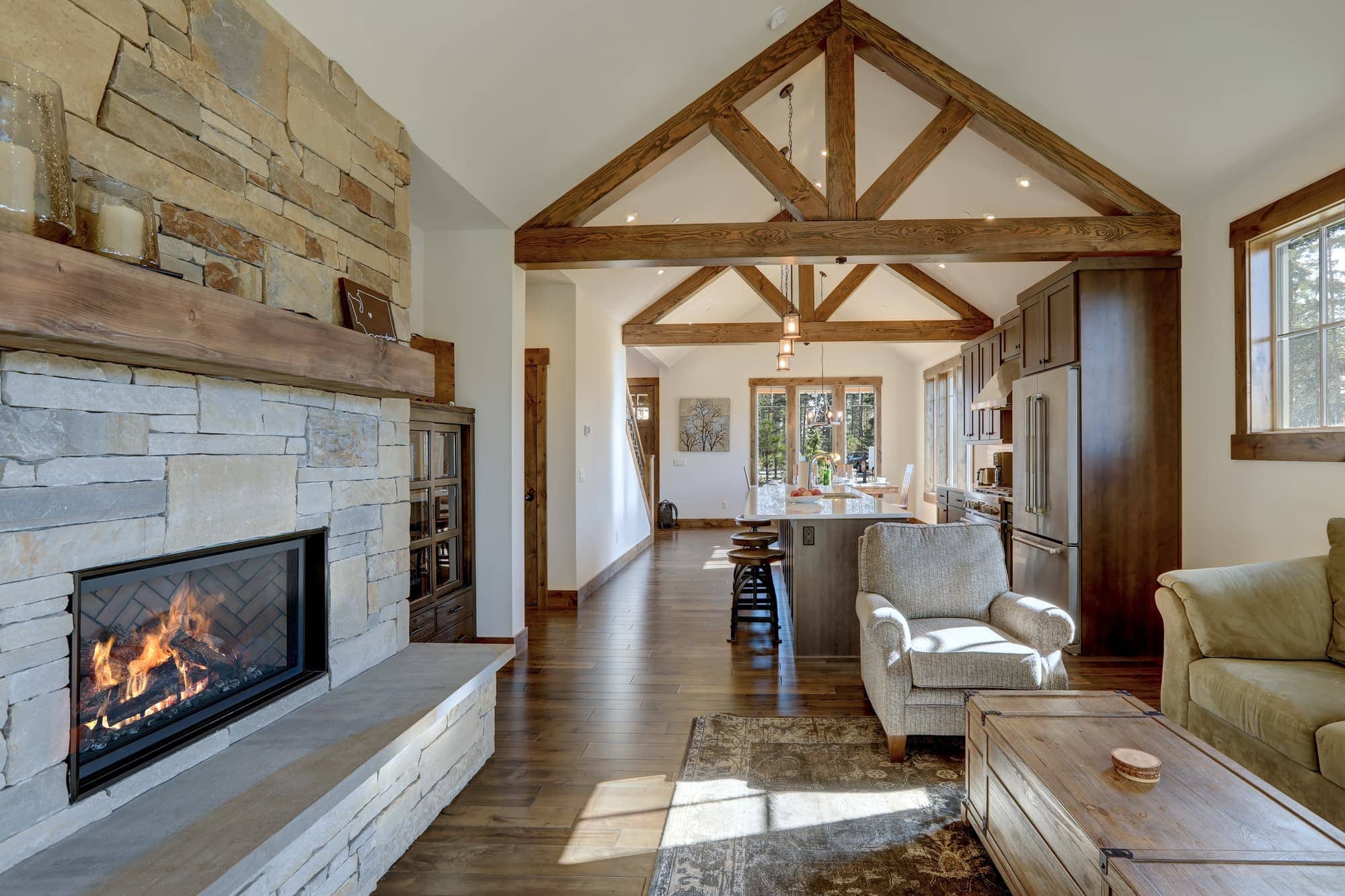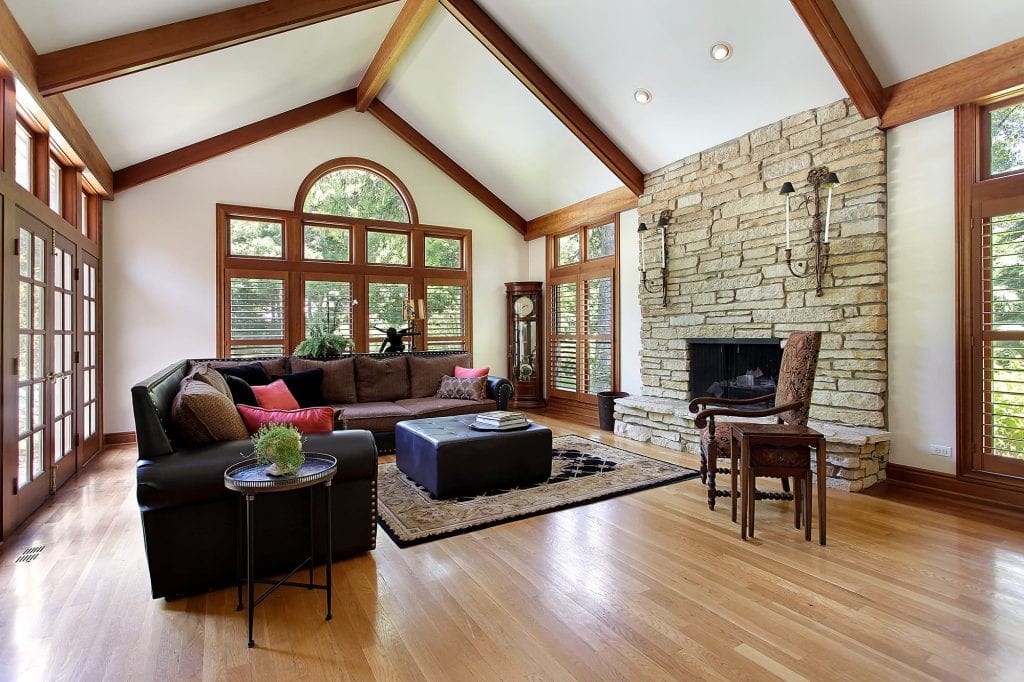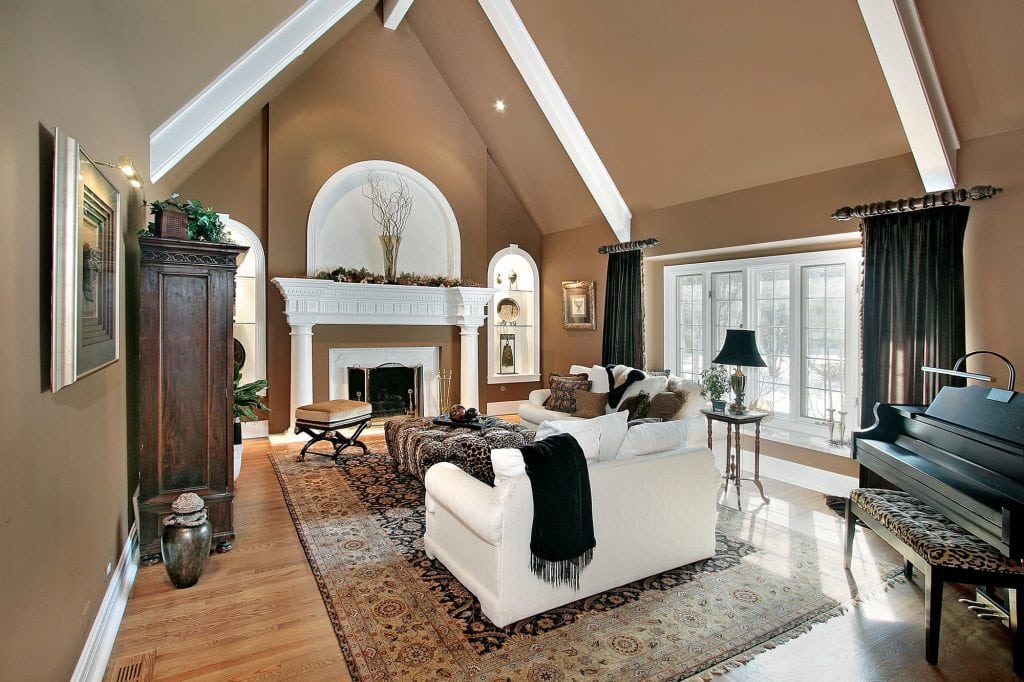A vaulted ceiling can transform an ordinary room into a stunning, spacious haven of architectural design. It’s no wonder why this home upgrade is increasingly on buyers’ wish lists. With a rich history and many design options, vaulted ceilings offer homeowners a chance to add grandeur and a sense of drama to their living space.
Plus, they’re a timeless feature that doesn’t go out of style, making them a smart investment for any homeowner. By incorporating vaulted ceilings into your home, you’ll be making a statement that’s sure to impress potential buyers and add value to your property.
Ready to learn more? This guide will provide you with all that you need to know to make informed decisions about this elegant home upgrade.
What is a Vaulted Ceiling?
A vaulted ceiling is a type of ceiling distinguished by its elevated height and arched or domed design. This construction style is known for creating a sense of grandeur and amplitude in any room, providing additional ceiling height and enhancing the overall spaciousness.
Traditionally found in churches and grand halls, vaulted ceilings are popular in many modern homes, enhancing living spaces with an air of luxury and sophistication.
Vaulted ceilings come in various styles, each with unique characteristics. Some common types include:
- Cathedral ceilings, distinguished by their high, symmetrical design and center ridge.
- Barrel vaults, named for their rounded, uniform arch reminiscent of a barrel’s inside.
- Dome vaults, featuring a circular, domed structure that spans an entire room.
The history of vaulted ceilings dates back centuries, with origins in the grand cathedrals of Europe. They were often adorned with intricate artwork and symbolized wealth and power. Today, they are a sought-after design element in homes, allowing homeowners to bring a touch of historical elegance into their daily lives.
The type of ceiling can dramatically alter a room’s ambiance, and vaulted ceilings are no exception. Their high peak creates a sense of magnificence and openness, making them popular for homeowners looking to maximize their living space and create a dramatic interior design statement.
However, it’s important to note that such a ceiling style may also bring extra costs and considerations, including higher energy bills due to the increased volume of space to heat or cool and potential challenges with lighting and maintenance. Therefore, it’s essential to carefully consider these factors when choosing to add a vaulted ceiling for your home.
Advantages for Home Buyers
Whether you’re planning on purchasing your dream house or renovating your current one, investing in a vaulted ceiling can offer multiple benefits. Let’s discuss how these architectural masterpieces can add value to your home.
Enhanced Aesthetic Appeal and Visual Impact
One of the most compelling reasons to opt for a vaulted ceiling is its heightened aesthetic appeal and visual impact. Vaulted ceilings lend a sense of elegance and luxury to a room, transforming even modest spaces into spectacular settings. With their elevated height, these ceilings create a dramatic statement that instantly elevates a room’s appeal.
Moreover, the extra height and spacious feeling of a vaulted ceiling provide a blank canvas for creative interior design and décor. The possibilities are endless, be it hanging grand light fixtures, incorporating dark wood beams for a rustic look, or showcasing a stunning stone fireplace.
Increased Natural Light and Sense of Openness
Another advantage of vaulted ceilings is their ability to increase natural light in the living space. By incorporating skylights, larger windows, or clerestory windows, you can maximize the entry of sunlight, enhancing the room’s brightness and creating an inviting and cheerful atmosphere.
Additionally, tall and ceiling windows can offer picturesque views of the outdoors, enhancing the room’s ambiance. This increased natural light and openness make vaulted ceilings an excellent choice for rooms with limited wall space or closed-off or cramped.
Improved Ventilation and Energy Efficiency
Contrary to popular belief, vaulted ceilings can improve your home’s ventilation and energy efficiency. These ceilings allow hot air to rise and cool air to circulate, promoting a more comfortable indoor environment, especially in regions with warmer climates.
Furthermore, in colder climates, using energy-efficient ceiling fans can help redistribute warm air that accumulates at the ceiling level, reducing the need for additional heating. This can lead to lower cooling and heating costs, proving that these dramatic spaces can also be energy efficient.
However, keep in mind that the impact on energy costs may vary based on factors such as the overall insulation of the home, the type of heating or cooling system installed, and the local climate.
Other advantages of vaulted ceilings include their potential to increase the perceived square footage of a room without physically altering its size, their ability to add value to a home in the real estate market, and the unique and personalized style they can offer to your living space. As such, whether you value aesthetics, natural light, energy efficiency, or all three, vaulted ceilings have much to offer.
Factors To Consider Before Installing Vaulted Ceilings
While vaulted ceilings offer numerous benefits, it’s important to carefully consider several factors before making the commitment to install one in your home.
Structural Considerations and Professional Assessment
The first thing to keep in mind is the structural feasibility of adding a vaulted ceiling to an existing structure. Not all homes are designed to accommodate the extra height and different weight distribution of a vaulted ceiling, and improper installation can compromise the structural integrity of your home.
Before making any decisions, consult with architects and engineers to evaluate your home’s current construction and determine if a vaulted ceiling is feasible. They can help assess factors such as the roof pitch, ceiling joists, and the presence or absence of an attic space, which can greatly influence the complexity and cost of the installation.
Practical Implications and Potential Challenges
Another consideration is the practical implications and potential challenges of having a vaulted ceiling. For instance, heating and cooling a room with a vaulted ceiling can pose challenges, as hot air rises and may accumulate in the ceiling area. An energy-efficient ceiling fan can help, but you must ensure your HVAC system can handle the additional load.
Maintenance and cleaning can also pose difficulties due to the extra height and space. Dusting light fixtures, changing bulbs, and painting can become more labor-intensive tasks.
Lastly, consider the construction costs, energy costs, and potential increase in utility bills. While vaulted ceilings can add value to your home, the upfront and long-term costs can be significant.
Tips To Maximize the Impact of Vaulted Ceilings
If you’ve decided that a vaulted ceiling is right for your home, here are a few tips to maximize its impact:
Accentuate Architectural Features
To fully take advantage of a vaulted ceiling, consider exposing and highlighting the structural elements like beams and trusses. Rustic wood or white beams can add character and charm to the ceiling while maintaining its structural integrity.
In addition to this, incorporating arched windows, clerestory windows, or decorative moldings can further accentuate the ceiling’s height and provide a more dynamic and visually appealing space.
Create a Focal Point with Lighting Fixtures
With the extra vertical space a vaulted ceiling provides, you can install dramatic and striking lighting fixtures. Chandeliers, pendant lights, or recessed lights can become a focal point in the room, drawing the eye upward and emphasizing the ceiling’s height.
Moreover, consider how you can effectively utilize natural and artificial lighting sources to enhance the mood and ambiance of the room.
Use Color Schemes and Paint Techniques
The right color scheme and paint techniques can dramatically enhance the sense of height and space in a room with a vaulted ceiling. Light colors like whites and pastels can make the room appear larger and more open. On the other hand, dark colors can create a cozy and intimate atmosphere.
Whether you match the ceiling color with your walls or use a contrasting color to highlight the ceiling’s unique shape, choose colors and finishes that complement your overall interior design and décor.
Remember, vaulted ceilings provide a unique opportunity to experiment with different design styles and aesthetics. Use this to express your creativity and create a home that truly reflects your taste and style.
Key Takeaways
Vaulted ceilings have stood the test of time, becoming a popular feature in modern homes due to their aesthetic appeal, sense of grandeur, and the additional space they provide. They offer a unique opportunity to transform the living space into a brighter, more open area that leaves a lasting impression.
When considering a home upgrade, a vaulted ceiling can add value from a financial and a comfort perspective. However, it’s vital to consider the considerations, such as structural feasibility and potential energy costs, before making a decision.
While the installation cost may seem significant initially, its increased value to your home can make it a worthy investment in the long run. Let your home stand out with a vaulted ceiling that speaks volumes about your aesthetic preference and love for spaciousness.
Ready to find your dream home with a vaulted ceiling? Start your home search at eXp Realty. You can also contact a local eXp agent to get more information on these properties.
FAQs: Vaulted Ceilings
Here are some of the commonly asked questions about vaulted ceilings:
What is a vaulted ceiling?
A vaulted ceiling is an architectural feature characterized by its height and arched design. It creates a more spacious and visually appealing overhead space in a room.
Is the vaulted ceiling good or bad?
A vaulted ceiling has both benefits and drawbacks. It enhances aesthetic appeal, provides extra space, and improves ventilation. However, it can increase energy costs and require more maintenance.
How much does it cost to build a vaulted ceiling?
The cost to build a vaulted ceiling varies based on factors like the type of ceiling, materials used, and the room size. On average, homeowners can expect to spend several thousand dollars on this project.
Why do people like vaulted ceilings?
People like vaulted ceilings because they add a sense of grandeur, increase natural light, and make the room feel more spacious and open.
What is the difference between a high ceiling and a vaulted ceiling?
A high ceiling refers to any ceiling above the standard height, typically flat. A vaulted ceiling, on the other hand, is characterized by its arched or domed shape and is generally much higher than a standard ceiling or a flat ceiling.
What style house has vaulted ceilings?
Vaulted ceilings can be found in various house styles but are particularly common in Contemporary, Craftsman, and Mid-century modern homes.
Do vaulted ceilings increase electric bills?
Yes, vaulted ceilings can increase the electric bill as they require more energy to heat and cool due to their larger volume.
Can any ceiling be vaulted?
Not all ceilings can be vaulted. The feasibility depends on the home’s existing structure, roof design, and presence of an attic.
Are vaulted ceilings harder to heat?
Yes, vaulted ceilings can be harder to heat due to their larger volume and hot air rises. However, this can be mitigated with the appropriate HVAC system and insulation.








